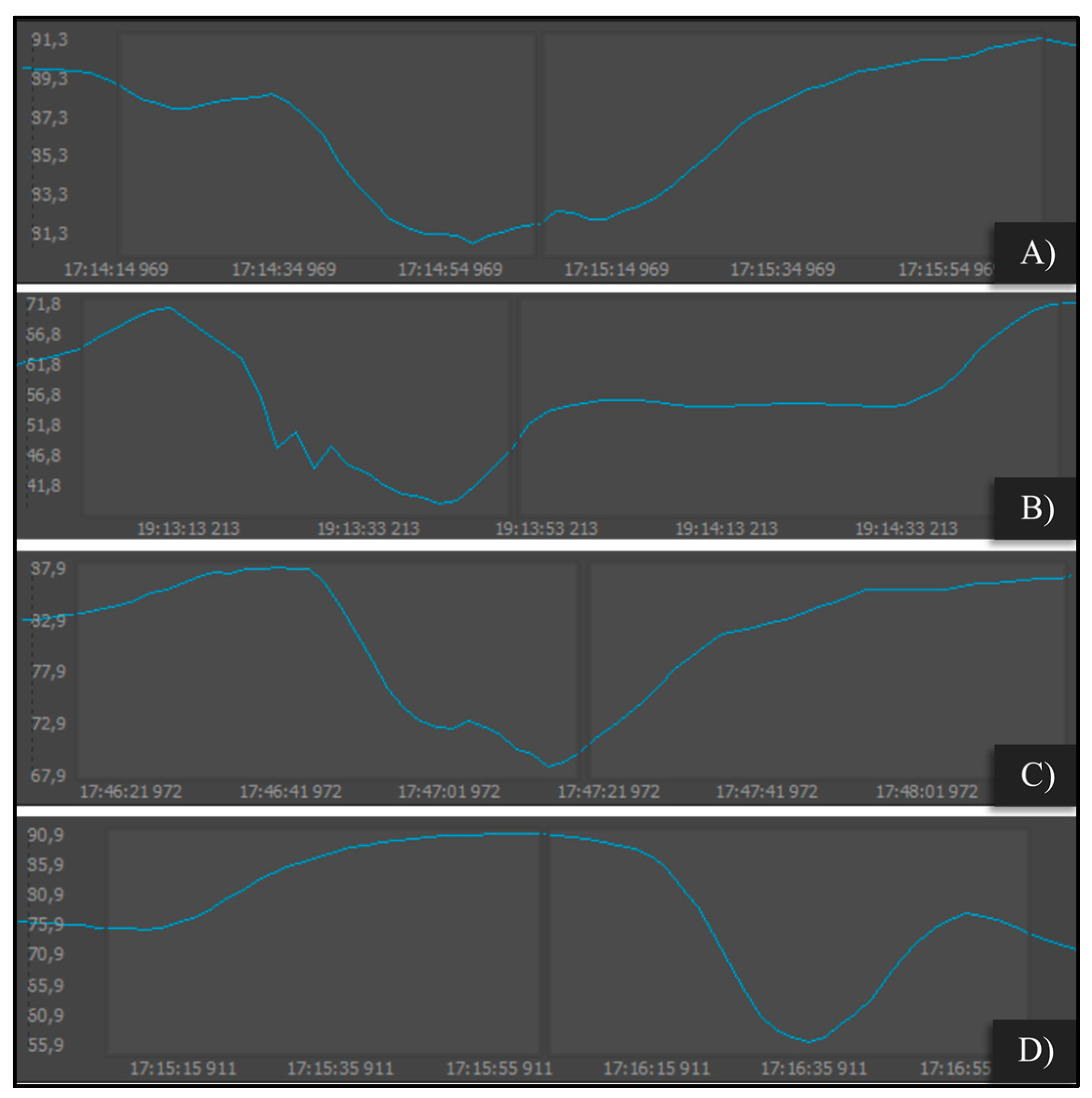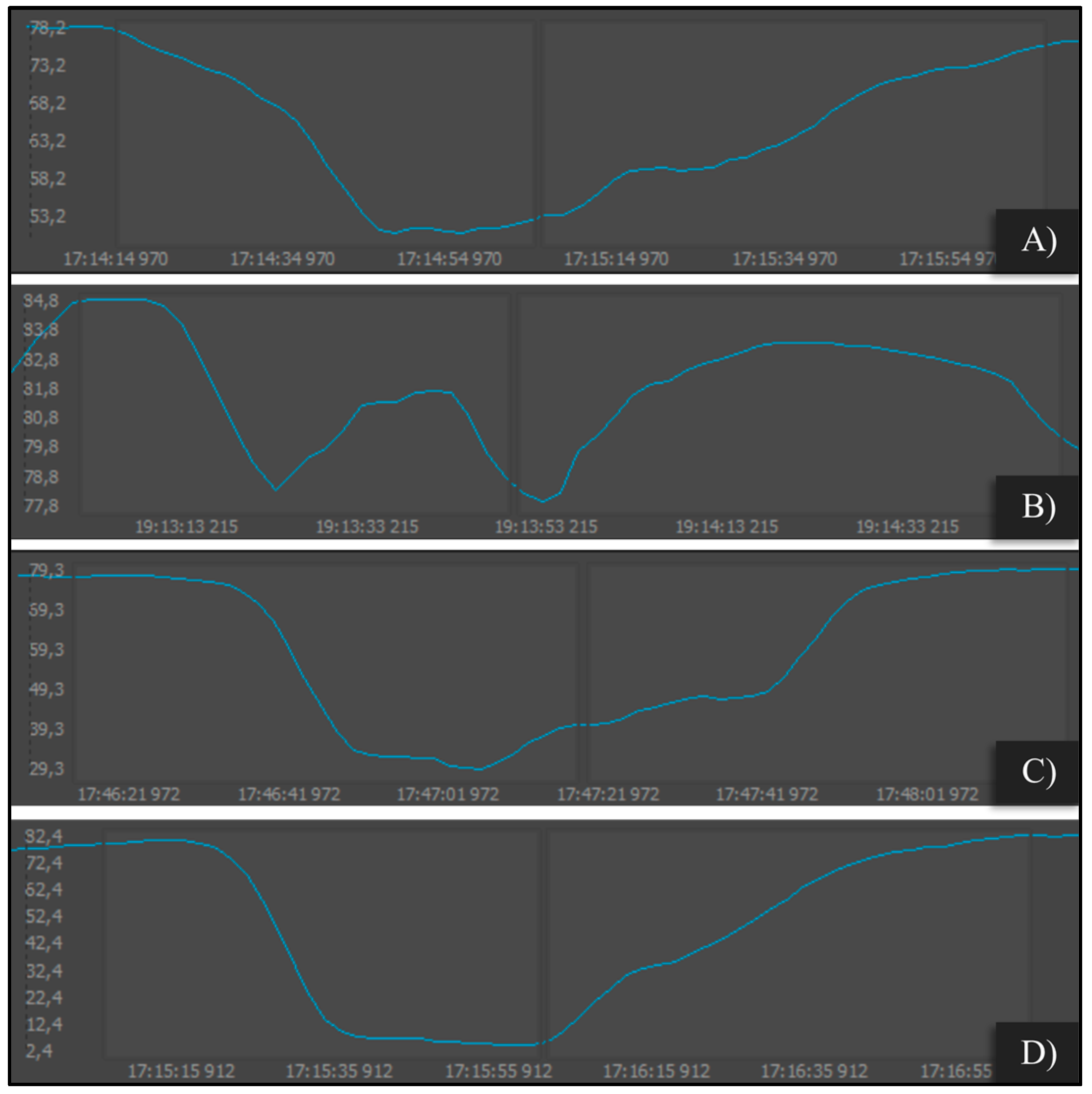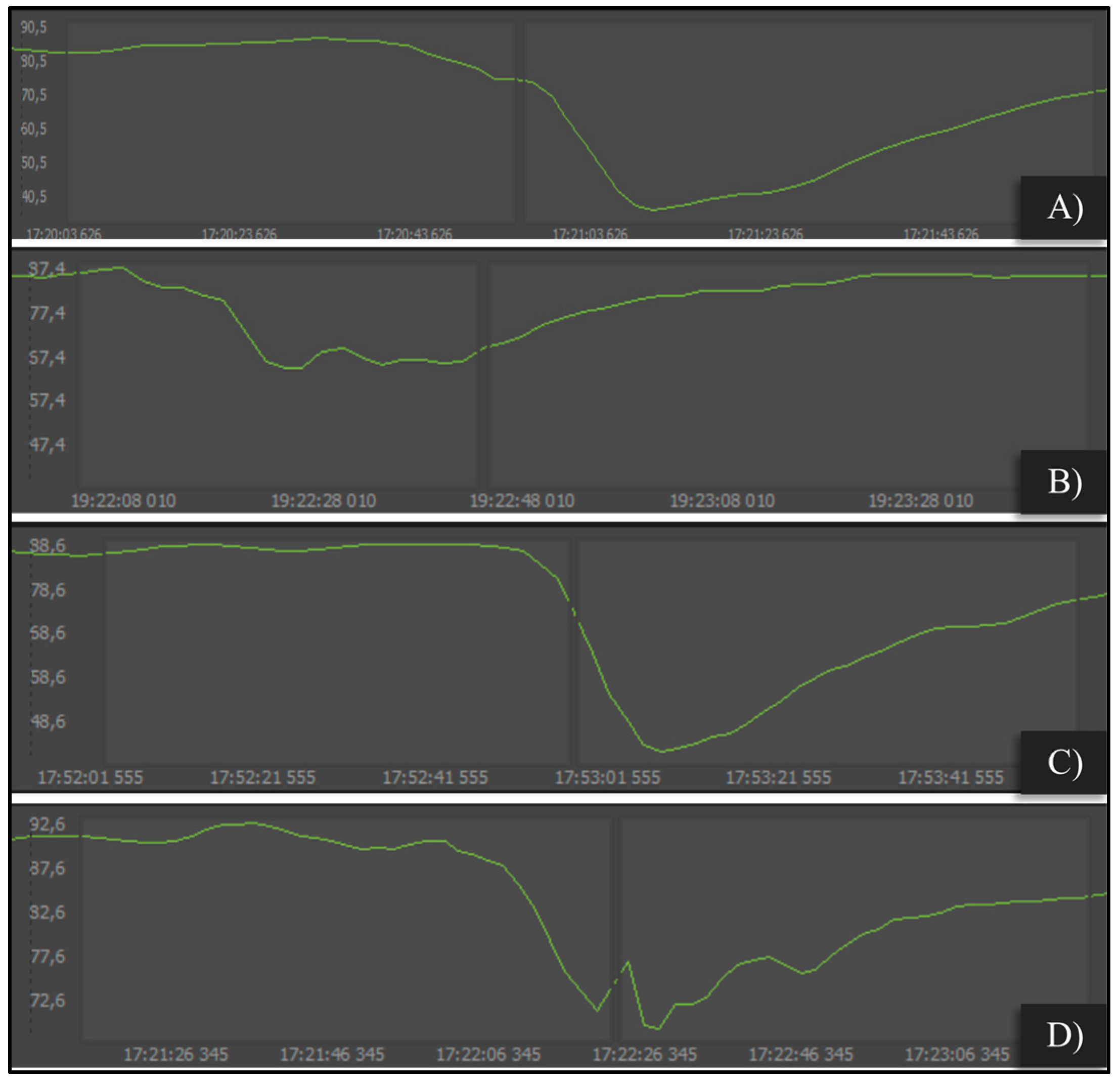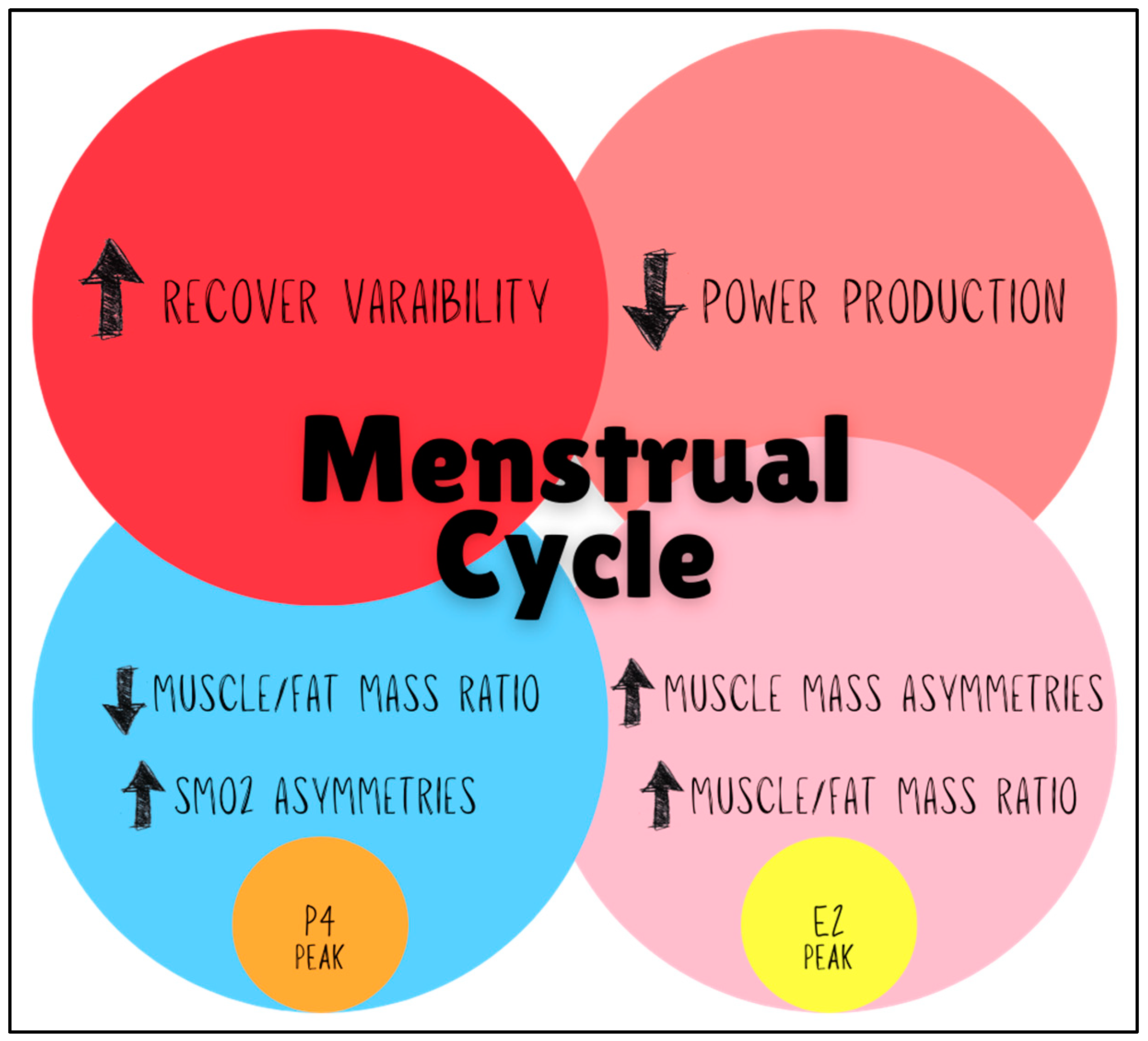Oxygen, Hormones, and Performance: A Case Study of Menstrual Cycle Effects on Athletic Physiology
Abstract
1. Introduction
2. Materials and Methods
2.1. Experimental Approach to the Problem
2.2. Subjects
2.3. Variables
2.4. Procedure
2.5. Statistical Analysis
3. Results
3.1. Verification of the Menstrual Cycle
3.2. Body Composition
3.3. Lower Body Power Production
3.4. Muscle Oxygen Saturation
3.4.1. Post-Exercise Muscle Oxygen Saturation Recovery
3.4.2. Dynamic Behaviour of Muscle Oxygen Saturation
4. Discussion
5. Conclusions
6. Practical Applications
- The observed relationship between improvements in anaerobic peak power and increased oestrogen levels in the blood suggests that intensive anaerobic power training should be prioritised during the ovulatory phase to maximise performance.
- Within the athlete’s menstrual cycle, maximal strength training is recommended during the preovulatory phase as this period is characterised by a significant rise in oestrogen levels, which may enhance strength adaptations.
- The development of new methodologies for menstrual cycle assessment should be encouraged, aiming to enhance specificity in female athlete evaluations and facilitate the individualisation of training programmes.
Author Contributions
Funding
Institutional Review Board Statement
Informed Consent Statement
Data Availability Statement
Conflicts of Interest
References
- Jiménez, M.R.; Aguilá, N.C. El ciclo menstrual y sus alteraciones. Pediatría Integral 2017, XXI, 304. [Google Scholar]
- Zanin, L.; Paez, A.; Correa, C.; De Bortoli, M. Ciclo menstrual: Sintomatología y regularidad del estilo de vida diario. Fundam. Humanidades 2011, 12, 103–123. [Google Scholar]
- Janse de Jonge, X.; Thompson, B.; Han, A. Methodological Recommendations for Menstrual Cycle Research in Sports and Exercise. Med. Sci. Sports Exerc. 2019, 51, 2610–2617. [Google Scholar] [CrossRef]
- Elliott-Sale, K.J.; Minahan, C.L.; de Jonge, X.A.J.; Ackerman, K.E.; Sipilä, S.; Constantini, N.W.; Lebrun, C.M.; Hackney, A.C. Methodological considerations for studies in sport and exercise science with women as participants: A working guide for standards of practice for research on women. Sports Med. 2021, 51, 843–861. [Google Scholar] [CrossRef]
- Paludo, A.C.; Paravlic, A.; Dvořáková, K.; Gimunová, M. The Effect of Menstrual Cycle on Perceptual Responses in Athletes: A Systematic Review with Meta-Analysis. Front. Psychol. 2022, 13, 926854. [Google Scholar] [CrossRef]
- Martínez-Fortuny, N.; Alonso-Calvete, A.; Da Cuña-Carrera, I.; Abalo-Núñez, R. Menstrual Cycle and Sport Injuries: A Systematic Review. Int. J. Environ. Res. Public Health 2023, 20, 3264. [Google Scholar] [CrossRef]
- Carmichael, M.A.; Thomson, R.L.; Moran, L.J.; Wycherley, T.P. The impact of menstrual cycle phase on athletes’ performance: A narrative review. Int. J. Environ. Res. Public Health 2021, 18, 1667. [Google Scholar] [CrossRef]
- Sarwar, R.; Niclos, B.B.; Rutherford, O. Changes in muscle strength, relaxation rate and fatiguability during the human menstrual cycle. J. Physiol. 1996, 493, 267–272. [Google Scholar] [CrossRef] [PubMed]
- Arenas-Pareja, M.d.l.Á.; López-Sierra, P.; Ibáñez, S.J.; García-Rubio, J. Influence of Menstrual Cycle on Internal and External Load in Professional Women Basketball Players. Healthcare 2023, 11, 822. [Google Scholar] [CrossRef]
- Watson, P.E.; Robinson, M.F. Variations in body-weight of young women during the menstrual cycle. Br. J. Nutr. 1965, 19, 237–248. [Google Scholar] [CrossRef]
- Fuentes, C.M. Efectos del Entrenamiento de Fuerza Muscular Sobre el Gasto Energético, Fatiga y Biomarcadores de Actividad Física en Adultos Sanos; Universidad de Granada: Granada, Spain, 2021. [Google Scholar]
- Paredes-Ruiz, M.-J.; Jódar-Reverte, M.; Ferrer-López, V.; González-Moro, I.M. Muscle oxygenation of the quadriceps and gastrocnemius during maximal aerobic effort. Rev. Bras. Med. Esporte 2021, 27, 212–217. [Google Scholar] [CrossRef]
- Thomas, J.R.; Martin, P.; Etnier, J.L.; Silverman, S.J. Research Methods in Physical Activity; Human Kinetics: Champaign, IL, USA, 2022. [Google Scholar]
- Halperin, I. Case studies in exercise and sport sciences: A powerful tool to bridge the science–practice gap. Int. J. Sports Physiol. Perform. 2018, 13, 824–825. [Google Scholar] [CrossRef]
- McKay, A.K.A.; Stellingwerff, T.; Smith, E.S.; Martin, D.T.; Mujika, I.; Goosey-Tolfrey, V.L.; Sheppard, J.; Burke, L.M. Defining Training and Performance Caliber: A Participant Classification Framework. Int. J. Sports Physiol. Perform. 2022, 17, 317–331. [Google Scholar] [CrossRef] [PubMed]
- Campbell, S.; Greenwood, M.; Prior, S.; Shearer, T.; Walkem, K.; Young, S.; Bywaters, D.; Walker, K. Purposive sampling: Complex or simple? Research case examples. J. Res. Nurs. 2020, 25, 652–661. [Google Scholar] [CrossRef] [PubMed]
- Lago Peñas, C.; Lorenzo-Calvo, A.; Cárdenas, D.; Alarcón, F.; Ureña, A.; Giménez Fuentes-Guerra, F.J.; Gómez-Ruano, M.A.; Fradua, L.; Sainz de Baranda, P.; Ibáñez, S.J. La creación de conocimiento en los deportes de equipo. Sobre el tamaño de la muestra y la generalización de los resultados. J. Univers. Mov. Perform. 2020, 1, 7–8. [Google Scholar] [CrossRef]
- Lockie, R.G.; Risso, F.G.; Lazar, A.; Giuliano, D.V.; Stage, A.A.; Liu, T.M.; Beiley, M.D.; Hurley, J.M.; Torne, I.A.; Stokes, J.J.; et al. Between-Leg Mechanical Differences as Measured by the Bulgarian Split-Squat: Exploring Asymmetries and Relationships with Sprint Acceleration. Sports 2017, 5, 65. [Google Scholar] [CrossRef]
- McCurdy, K.; Langford, G.A.; Cline, A.L.; Doscher, M.; Hoff, R. The Reliability of 1- and 3Rm Tests of Unilateral Strength in Trained and Untrained Men and Women. J. Sports Sci. Med. 2004, 3, 190–196. [Google Scholar]
- Atkinson, G.; Nevill, A.M. Statistical Methods For Assessing Measurement Error (Reliability) in Variables Relevant to Sports Medicine. Sports Med. 1998, 26, 217–238. [Google Scholar] [CrossRef]
- Bourbousson, J.; Sève, C.; McGarry, T. Space–time coordination dynamics in basketball: Part 1. Intra- and inter-couplings among player dyads. J. Sports Sci. 2010, 28, 339–347. [Google Scholar] [CrossRef]
- Bonilla, A.A.V.; Sayavera, F.J.B.; Andrada, R.T.; Camacho, G.J.O. Measurement of resting muscle oxygenation and the relationship with countermovement jumps and body composition in soccer players. Cult. Cienc. Y Deporte 2021, 16, 215–223. [Google Scholar] [CrossRef]
- Kissow, J.; Jacobsen, K.J.; Gunnarsson, T.P.; Jessen, S.; Hostrup, M. Effects of Follicular and Luteal Phase-Based Menstrual Cycle Resistance Training on Muscle Strength and Mass. Sports Med. 2022, 52, 2813–2819. [Google Scholar] [CrossRef] [PubMed]
- Sung, E.; Han, A.; Hinrichs, T.; Vorgerd, M.; Manchado, C.; Platen, P. Effects of follicular versus luteal phase-based strength training in young women. SpringerPlus 2014, 3, 668. [Google Scholar] [CrossRef]
- Ekenros, L.; Hirschberg, A.L.; Heijne, A.; Fridén, C. Oral contraceptives do not affect muscle strength and hop performance in active women. Clin. J. Sport Med. 2013, 23, 202–207. [Google Scholar] [CrossRef] [PubMed]
- Reis, E.; Frick, U.; Schmidtbleicher, D. Frequency Variations of Strength Training Sessions Triggered by the Phases of the Menstrual Cycle. Int. J. Sports Med. 1995, 16, 545–550. [Google Scholar] [CrossRef]
- Romero-Moraleda, B.; Morencos-Martínez, E.; Varón, P.; Lara, B.; Jiménez-Ormeño, E.; Peinado, A.B.; González-García, J. The influence of menstrual cycle phase on neuromuscular performance and subjective perception of effort in elite football players. Biol. Sport 2025, 42, 89–98. [Google Scholar] [CrossRef]
- Dehghan, F.; Soori, R.; Yusof, A. Mudanças na flacidez do joelho com esteroides sexuais durante as fases do ciclo menstrual em mulheres atletas e não atletas. Rev. Bras. Ortop. 2024, 59, e29–e37. [Google Scholar] [CrossRef]
- Johnson, K.A.; Shields, R.K. Influence of the Menstrual Cycle and Training on the Performance of a Perturbed Single-Leg Squatting Task in Female Collegiate Athletes. Orthop. J. Sports Med. 2024, 12, 23259671241251720. [Google Scholar] [CrossRef]
- Bataller, A.G. Entrenamiento Específico para Mujeres; Universidad Carlos III de Madrid: Getafe, Spain, 2019; p. 117. [Google Scholar]
- Sipavičienė, S.; Daniusevičiutė, L.; Klizienė, I.; Kamandulis, S.; Skurvydas, A. Effects of estrogen fluctuation during the menstrual cycle on the response to stretch-shortening exercise in females. BioMed Res. Int. 2013, 2013, 243572. [Google Scholar] [CrossRef]
- Pallavi, L.; SoUza, U.J.D.; Shivaprakash, G. Assessment of musculoskeletal strength and levels of fatigue during different phases of menstrual cycle in young adults. J. Clin. Diagn. Res. 2017, 11, CC11. [Google Scholar] [CrossRef]
- Hostrup, M.; Bangsbo, J. Limitations in intense exercise performance of athletes—Effect of speed endurance training on ion handling and fatigue development. J. Physiol. 2017, 595, 2897–2913. [Google Scholar] [CrossRef]
- Kishali, N.F.; Imamoglu, O.; Katkat, D.; Atan, T.; Akyol, P. Effects of menstrual cycle on sports performance. Int. J. Neurosci. 2006, 116, 1549–1563. [Google Scholar] [CrossRef] [PubMed]







| TLM 1 | TFM 2 | DLLM 3 | NDLLM 4 | ||||
|---|---|---|---|---|---|---|---|
| kg | % | kg | % | kg | % | kg | % |
| 39.5 | 73.97 | 11.80 | 22.10 | 6.80 | 17.20 | 6.60 | 16.70 |
| E2 1 | FSH 2 | LH 3 | P4 4 | |
|---|---|---|---|---|
| pg/mL | pg/mL | mUl/mL | ng/mL | |
| Pre-test | 127.0 | 4.5 | 18.7 | 6.15 |
| Post-test | 376.0 | 1.7 | 10.0 | 19.90 |
| Weight | TLM 1 | TFM 2 | DLMM 3 | NDLMM 4 | |||
|---|---|---|---|---|---|---|---|
| kg | kg | kg | kg | % | kg | % | |
| Menstruation | 53.4 | 39.5 | 11.80 | 6.80 | 17.20 | 6.60 | 16.70 |
| Follicular phase | 53.4 | 40.4 | 10.80 | 6.80 | 16.80 | 6.70 | 16.60 |
| Ovulation phase | 53.3 | 40.4 | 10.70 | 6.90 | 17.10 | 6.70 | 16.60 |
| Luteal phase | 53.4 | 38.8 | 11.90 | 6.80 | 16.80 | 6.70 | 16.60 |
| Menstruation | F.P. 1 | O.P. 2 | L.P. 3 | |
|---|---|---|---|---|
| Dominant Leg | 9 | 5 | 14 | 19 |
| Non-dominant Leg | 8 | 4 | 13 | 19 |
Disclaimer/Publisher’s Note: The statements, opinions and data contained in all publications are solely those of the individual author(s) and contributor(s) and not of MDPI and/or the editor(s). MDPI and/or the editor(s) disclaim responsibility for any injury to people or property resulting from any ideas, methods, instructions or products referred to in the content. |
© 2025 by the authors. Licensee MDPI, Basel, Switzerland. This article is an open access article distributed under the terms and conditions of the Creative Commons Attribution (CC BY) license (https://creativecommons.org/licenses/by/4.0/).
Share and Cite
Martínez-Sánchez, A.; Campos-Redondo, A.; Ibáñez, S.J.; García-Rubio, J. Oxygen, Hormones, and Performance: A Case Study of Menstrual Cycle Effects on Athletic Physiology. Appl. Sci. 2025, 15, 3749. https://doi.org/10.3390/app15073749
Martínez-Sánchez A, Campos-Redondo A, Ibáñez SJ, García-Rubio J. Oxygen, Hormones, and Performance: A Case Study of Menstrual Cycle Effects on Athletic Physiology. Applied Sciences. 2025; 15(7):3749. https://doi.org/10.3390/app15073749
Chicago/Turabian StyleMartínez-Sánchez, Almudena, Amalia Campos-Redondo, Sergio J. Ibáñez, and Javier García-Rubio. 2025. "Oxygen, Hormones, and Performance: A Case Study of Menstrual Cycle Effects on Athletic Physiology" Applied Sciences 15, no. 7: 3749. https://doi.org/10.3390/app15073749
APA StyleMartínez-Sánchez, A., Campos-Redondo, A., Ibáñez, S. J., & García-Rubio, J. (2025). Oxygen, Hormones, and Performance: A Case Study of Menstrual Cycle Effects on Athletic Physiology. Applied Sciences, 15(7), 3749. https://doi.org/10.3390/app15073749







